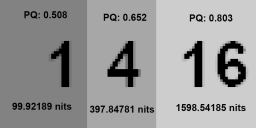| Welcome, Guest |
You have to register before you can post on our site.
|
| Latest Threads |
Total Recall 35mm Regrade
Forum: In progress
Last Post: lalajones
1 hour ago
» Replies: 26
» Views: 10,705
|
Minority Report (2002) - ...
Forum: Released
Last Post: uVSthem
Yesterday, 09:41 PM
» Replies: 3
» Views: 159
|
hello! I had no idea this...
Forum: Presentation
Last Post: CSchmidlapp
2025-12-12, 09:39 PM
» Replies: 3
» Views: 207
|
The Bourne Identity - The...
Forum: Released
Last Post: HD335
2025-12-12, 05:25 AM
» Replies: 38
» Views: 13,002
|
TROY (2004) - Replace Sco...
Forum: Requests, proposals, help
Last Post: five2one
2025-12-11, 11:37 AM
» Replies: 30
» Views: 15,329
|
Superman: The Movie 4K
Forum: Official and unofficial releases
Last Post: AdmiralNoodles
2025-12-11, 09:08 AM
» Replies: 69
» Views: 69,636
|
Peanuts DVD mono synched ...
Forum: Released
Last Post: uVSthem
2025-12-11, 04:45 AM
» Replies: 17
» Views: 10,932
|
Films that used silver re...
Forum: Official and unofficial releases
Last Post: Virtualcrane
2025-12-11, 01:19 AM
» Replies: 31
» Views: 41,149
|
Hello Everyone
Forum: Presentation
Last Post: don912
2025-12-10, 04:21 PM
» Replies: 0
» Views: 78
|
Hey
Forum: Presentation
Last Post: Jae55555
2025-12-10, 03:27 PM
» Replies: 1
» Views: 89
|
|
|
| Hey hey! |
|
Posted by: buseipek - 2020-01-01, 10:37 PM - Forum: Presentation
- Replies (5)
|
 |
Hello there!
It's my first post here and I'm very nervous..
So anyways let me introduce myself!
My name's Buse andd I'm a girl, I'm 18.
I'm from Turkey and I've been reading comics/manga since 2018, I'm also kind of new to anime.
My obsession with Star Wars stated in 2017 which is also the first time I watched the Saga.
I graduated from High School last year and I have a cat!
There's not much that I can think of so yeah
I hope we can get along!! I already loved this place!
|

|
|
| "La Classe américaine" 26th anniversary Special Edition in fool HD* |
|
Posted by: Beber - 2019-12-30, 04:18 PM - Forum: Released
- Replies (15)
|
 |
![[Image: Jml1R.jpg]](https://i.goopics.net/Jml1R.jpg)
George Abitbol, "the Classiest Man on Earth", dies sputtering his famous last words: "Shitty world!" What the heck did he mean? Reporters Steven, Peter and Dave investigate. La Classe américaine is a comedy montage of scenes taken from the Warner Bros. catalog and dubbed to fit the narration.
https://www.imdb.com/title/tt0321715/?ref_=ttpl_pl_tt
For more information on the project, see the original thread here: https://fanrestore.com/thread-2768.html?...%A9ricaine
* So why Special Edition? Why "fool" HD ? Why, why, why indeed? Since I like you guys, I'll tell you all:
- One, 'cause it's a restoration made in the digital era using digital tools unavailable at the time, based on the maximum amount of HD sources available at the moment, to which SD upscales were added to complete the montage.
- Two, 'cause the flashback scene of the writing of the letter is cut shorter on the source DVD, so the edit had to be modified using the onward/backward repetition technique used many times in the movie anyway, to circumvent this issue.
- Three, 'cause the lightening bolt shots in the beginning were never identified as to which movie they came from, so these were replaced by lovely restored ones from a MGM/Warner Home Video movie prior to 1993 to still be in the spirit of the original restrictions. Plus it gives the scene enhanced visual effects à la "Star Wars 'Special Edition'".
- Four, 'cause the whole thing was color timed and degrained to better sell the illusion that the shots are part of the same scenes.
- And finally five.... There is no five.
Video: 1080p @ 25 fps.
Aspect ratio: 2.20:1 just like the 70mm print that never was.
Audio: French PCM stereo and AAC stereo with a fixed line that was clearly out of sync, even more obvious in HD.
Subtitles: French for the hearing impaired, English (pardon my grammar, I asked for an English-speaking proofreader but no one answered), and English informative as to what movie is being used in the montage.
Trailer: specially made for this 26th anniversary Special Edition, also included in the package.
Special thanks to:
CorVans Prod YouTube channel tutorials for DaVinci Resolve 15.
ilovewaterslides for his help on a handful of shots that required visual effects.
Colek, Plissken1138 for helping me locating movie sources.
Direct MEGA link on demand via PM (for active members only), also available on my YouTube channel created just for this project: https://www.youtube.com/channel/UCBgdii0...uRfw6QKE3A
|

|
|
| Neverending Story: Dutch Audio |
|
Posted by: Croweyes1121 - 2019-12-29, 10:03 PM - Forum: Requests, proposals, help
- Replies (19)
|
 |
I don’t know what the differences are, but I’m told that the Blu-ray from Holland has a superior audio track to the US Blu-ray. I’m currently in the process of creating a restored International Cut using the German 4K remastered release and would like to test the Dutch audio track to see if it would be a better option for the project. I do not need the video, audio only.
|

|
|
| hardware for capturing Laserdisc video |
|
Posted by: markosjal - 2019-12-29, 11:48 AM - Forum: Capture and rip
- Replies (10)
|
 |
I am looking at doing Laserdisc captures from Composite video.
I hoped someone may have some advice on what to use. I think DVD recorders and DVD format in feneral produce way too much artifacting. I would also prefer a format better for editing where necessary
Has anyone tested extensively With a DV Firewire capture device?
Thanks
Mark
|

|
|
| Alien D-Theater: Keep or Ditch? |
|
Posted by: bendermac - 2019-12-27, 11:43 PM - Forum: Movies, TV shows and other
- Replies (5)
|
 |
With the 4K release available in stores, which is arguably the best the movie has ever looked, I do wonder if I can safely delete the D-Theater of the Director's Cut. I haven't compared the versions on the 4K and DTH, but maybe someone here did it. If you did, what's your verdict: Keep or Ditch?
|

|
|
| Technical aspects/workflow of HDR grading & encoding |
|
Posted by: deleted user - 2019-12-26, 02:32 PM - Forum: Audio and video editing
- Replies (1)
|
 |
May this be a general thread for discussing HDR from a technical & workfllow perspective for those interested in encoding and creating HDR content.
I'll start out with something I wanna share, a little bit of information regarding nits and the HDR curve and such, based on my own experiments. Also wanna preface this by saying I don't have a HDR display, so this is mostly considerations from a technical perspective.
The usefulness of these thoughts I will explain on the bottom of the post.
Here's my experiment:

Here's what I did:
1. Created a 32bit floating point image in Photoshop, with a custom linear sRGB colorspace (gamma set to 1).
2. Created 3 white rectangles. The darkest one had intensity set to 1. That means that on a normal display it reaches peak brightness. Then I created another one with an intensity of 4, equivalent to a 2 stop overexposure. I could do this thanks to the 32bit floating point space in Photoshop. And then a third one with an intensity of 16, equivalent to a 4 stop overexposure. On my display they all simply looked equally white.
3. Saved this image as an OpenEXR file (supports overbright values >1).
4. Opened this OpenEXR file in After Effects and told AE to interpret it as linear sRGB, like it was saved. Set After Effects project setting to 32 bit floating point with, again, linear sRGB color space. The linear color space is important to arrive at the correct values, gamma only complicates things. In linear color space, 2 simply means twice as much light as 1, 4 twice as much as 2, and so on.
5. Exported as 16 bit TIFF, but made sure to set a Rec2020 PQ HDR ICC Profile for the export. This makes AE automatically convert the superbright (>1) values into the HDR PQ color space. PQ is the same color space that most (if not all) UHD HDR Blu Rays use.
6. The resulting TIFF I opened in Photoshop and interpreted (not converted!) the colors as normal sRGB. This was just done for convenience, so that the image you see above has visible shades, otherwise Photoshop automatically *converts* into sRGB and thus all the shades are pure white again, which for this demonstration isn't very useful, as I wanna see that it actually worked and I ended up with different shades, or in other words, that the superbright detail was actually preserved.
7. Now I hovered the mouse over the different shades while having the mode in the Info-window set to 32 bit floating point. Thus I got the values you can see written on top as "PQ: ". Those are values between 0 and 1, representing the actual RGB brightness in the PQ-HDR-encoded image (or video). Of course that 0-1 would be scaled up to, for example, 0-1023 for 10 bit HDR video, it's merely a different way of displaying the data. I chose the 0-1 representation mainly because of the next step:
8.

Link: https://github.com/colour-science/colour...st_2084.py
This script is part of the colour-science package in Python. It basically converts the raw PQ signal value to nits. This is possible because with PQ HDR (the de facto standard these days) every value in the encoded video corresponds precisely with an intensity in nits. You can see in the screenshot how to call the script, if you want to test it out yourself. I did this with Anaconda in the Anaconda prompt. Details on how to get it working on the bottom of the post.
9. I noted the resulting nit brightness on the bottom in my little graphic on the top of this post.
10. As you can see, there's a clear pattern we can see: A fully bright pixel (intensity of 1) in a 32 bit floating point composition in After Effects corresponds with pretty much exactly 100 nits (probably some rounding errors somewhere). A pixel with the intensity of 4 corresponds with pretty much exactly 400 nits, and the pixel with an intensity of 16 has a brightness of 1600 nits.
Why is this useful?
Simple. Let's say you have some linear footage like, for instance ... a film scan. Typically this scan will be rather dark due to headroom necessary to avoid clipped highlights. In a normal SDR grade you would use some form of curves to compress the highlights without blowing them out, for instance via Gamma, or by hand, in order to get more detail in the shadows.
In an HDR grade, you can do this instead: Make sure you're in a linear color space and 32 bit floating point in After Effects. Apply the "Exposure" filter. Set Exposure to a value that gives you enough detail in the shadows. You will now have blown out highlights, but don't worry, it's all part of the plan. Next, export the video while setting a Rec2020 PQ color profile for the export. After Effects will automatically convert the blown out highlights (which aren't really blown out) into the correct HDR values. You don't even need an HDR display to do this. Great!
And here's where all this information comes in super handy too: In order to make a proper HDR encode that is compatible and works, you need to supply metadata. Most importantly, the peak brightness. This value doesn't affect the image per se, rather it gives TVs a hint on how to remap superbright values if they cannot reach the brightness of the content. Normally you would just have to guess some random value. If you guess too low, you may end up with clipped highlights, because the TV doesn't take them into account when tonemapping. If you guess too high, your image will end up too dark after tonemapping because the TV tries to take into account a very high peak brightness that is never actually reached.
With the information we have though, we can give it the correct value. Let's say you have your linear footage in your composition without any adjustments. Now you know that the brightest possible pixel in the footage will be an intensity of 1. We also know that 1 means 100 nits. Now, if you raise Exposure by, say, 2 stops, via the Exposure effect, you get an intensity of 4 (one stop means the amount of light doubles). And we also know that an intensity of 4 equals 400 nits.
Whatever Exposure adjustment you set under the described circumstances, you can simply multiply it by 100 and get the theoretical peak brightness in nits.
So for instance:
Exposure +1 stop = 200 nits peak
Exposure +2 stops = 400 nits peak
Exposure +3 stops = 800 nits peak
Exposure +4 stops = 1600 nits peak
With the film scans I tested so far, typically a value between 2 and 3 stops seems good to me, so you get a peak brightness somewhere between 400 and 800 nits.
Which coincidentally is in the range that the new Star Wars HDR remasters reach. Many people said it wasn't "true HDR", but I disagree based on the film scans I played around with, it's a pretty believable range for 35mm content. Granted, a scan from the negative might reveal more range in theory, but you wouldn't get that kind of range in the cinema on 35mm, so it's pretty "faithful" in that aspect imo.
How can I do that fancy Python script stuff myself?
I say fancy because I'm a complete Python noob myself, but anyway, here's how I did it:
1. Install Anaconda (it's a kind of Python package/distribution or sth)
2. Run Anaconda Prompt
3. Do this:
Code: pip install colour-science
5. Do this:
Code: import colour as colour
Code: colour.models.eotf_ST2084(0.5)
7. Receive the corresponding nit intensity as a result.
Hope this can be useful to someone someday.  I'm no expert or anything, but thought I'd share the little I figured out to demystify HDR a little. I'm no expert or anything, but thought I'd share the little I figured out to demystify HDR a little.
|

|
|
| Merry Christmas Fanressers! |
|
Posted by: Bigrob - 2019-12-24, 03:22 PM - Forum: Everything else...
- Replies (13)
|
 |
Just taking this opportunity now to wish all members and contributors on Fan Res a very merry Christmas and a happy new year! Can't wait to see what projects are done during 2020!
I'm off now recovering from shoulder surgery yesterday. Finally managed to get my surround system wired up after two years in storage so looking forward to checking out some of the projects on here finally!
|

|
|
| Thumbnail script with scene detection |
|
Posted by: deleted user - 2019-12-23, 06:04 AM - Forum: Script snippets
- Replies (1)
|
 |
Made this bash script (can be used on Windows with the Git Bash that comes with the Git installer) for creating thumbnails.
Difference to other thumbnail creating possibilities is that this one uses scene detection, so it's suited well for shorter videos like trailers when you want to get every distinct shot.
It's not perfect - you get blank frames for example during short flashes and it won't recognize faded changes usually, but I'm happy with it.
Requirements
- Ability to run .sh scripts. So either run in Linux or install a bash for Windows (for example Git Bash that comes with the Git installer)
- ffmpeg in the PATH.
- That's it!
How to use
1. Replace "Trailer.mkv" with the file you want to create thumbnails for
2. Set "columns" to how many columns of thumbnails you want to be displayed side-by-side
3. Set "columnwidth" to the width in pixels an individual thumbnail should have
4. Set "maxrows" to a high enough estimated number to fit in all thumbnails (from your experience and experiments) and then add 10. It's a bit awkwardly done, but ffmpeg needs you to set the amount of thumbnail tiles in advance, hence this script has a second cropping stage.
5. Set "scenedetect" to a value depending on your content. Lower values make it more sensitive. However darker scenes require higher sensitivity. It's a bit dumb, but I don't know a better way. For dark videos I recommend values around 0.2 and for bright content around 0.4.
6. Adjust JPEG quality if you want, but I don't know if it actually makes a difference for ffmpeg. Might replace this with a better JPEG compressor but I wanted this to work with the only dependency being ffmpeg.
7. Double click the script and wait for it to finish. Can take a little while.
The script will always create both .png and .jpg formats. Just keep the one you prefer.
Script (save as somefile.sh):
Code: #!/bin/bash
inputfile="Trailer.mkv"
columns=4
columnwidth=640
maxrows=30
scenedetect=0.2 #Scene detection treshold. Lower = greater detection. Try around 0.2 for dark videos and 0.4 for normal videos
jpegquality=1 #JPEG quality from 1-31 with 31 being worst quality (not sure if this works!)
x="x"
tmpfile="$inputfile.tmp.bmp"
outputfile="$inputfile.png"
outputfilejpg="$inputfile.jpg"
tiles="$columns$x$maxrows"
echo "Doing scene analysis: $inputfile ..."
ffmpeg -i "$inputfile" -vf select="gt(scene\,$scenedetect)",scale=$columnwidth:-1,tile=$tiles -hide_banner -frames:v 1 "$tmpfile" 2>/dev/null
echo "Generated temporary uncropped tile file $tmpfile ..."
cropvalue=`ffmpeg -loop 1 -r 1 -i "$tmpfile" -t 2 -r 1 -vf cropdetect=0:1:0 -f null - 2>&1 | awk '/crop/ { print $NF }' | tail -1`
echo "Calculated crop value: $cropvalue"
echo "Generating PNG file: $outputfile"
ffmpeg -i "$tmpfile" -vf $cropvalue -hide_banner "$outputfile" 2>/dev/null
echo "Generating JPG file: $outputfilejpg"
ffmpeg -i "$tmpfile" -vf $cropvalue -hide_banner -q:v $jpegquality "$outputfilejpg" 2>/dev/null
echo "Deleting temporary file: $tmpfile"
rm "$tmpfile"
read -rsp $'(Hopefully) done! Press any key to continue...\n' -n1 key
|

|
|
|